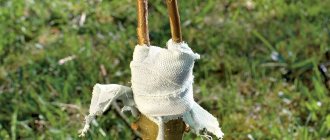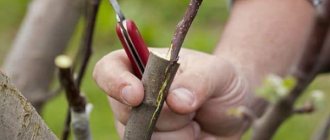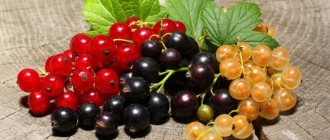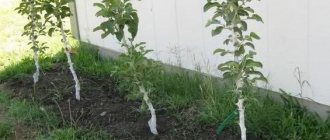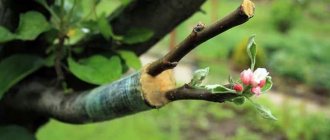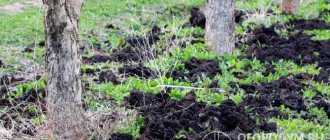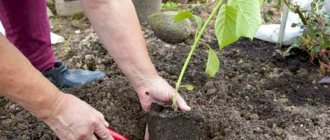Is it possible to graft a pear onto an apple tree?
Introduction
Grafting one tree onto another can serve several purposes . This:
- Experiments to improve the quality of fruits;
- The ability to replace small or tasteless fruits from your tree with more desirable, high-quality ones;
- Rational use of the garden area when it is small;
- Tree treatment, renewal;
- Creating an assortment of fruits on one root.
This also makes it possible, having a developed rootstock and a healthy scion cutting, to get a fruit-bearing new plant in a short time.
Pear and apple trees, being pome fruit trees, make it possible to graft one onto the other.
Important! It is necessary to observe the timing of vaccinations, as well as the characteristics of the rootstock, as this will affect the yield, size of the tree and its crown.
An incorrect choice of vaccination time, temperature regime, as well as unsuitable weather conditions on a given day can lead to vaccination rejection .
Is it possible to graft a pear onto an apple tree?
There are positive examples of grafting these heterogeneous trees. They develop safely and bear fruit.
Successful practice of grafting a pear onto an apple tree.
But it also happens that if the first stage of grafting is successfully completed, the grafted branch may subsequently be suppressed and then rejected.
The grafting site may also grow . This is explained by the fact that the compatibility of the rootstock and scion is not complete.
Experienced gardeners solve this problem in different ways .
One of them is the grafting (next spring) of a young shoot that grew on the scion over the summer onto another branch of the same rootstock. This young shoot, which has already grown on the juices of the rootstock, becomes more compatible with it. And rejection no longer occurs.
The second method is called intercalary insertion - another link is grafted between the rootstock and scion. This insertion of a fruit plant is an intermediate tier between the rootstock and scion. This is part of the stem of another rootstock, a cutting, which affects the entire plant and the compatibility of the rootstock and scion.
A little theory: problems of compatibility of rootstocks and scions
Pear and apple are pome crops. If the characteristics of the rootstock and timing are observed, vaccinations proceed safely. But there are cases when the grafted branch begins to be rejected in the future. This happens due to the incompatibility of the rootstock and the scion.
Apple and pear trees are crops that can be successfully crossed
There are two options to solve this problem:
- In the first case, a young shoot can be grafted next spring, which appeared on the scion over the summer, onto another branch of the same rootstock. The young shoot will already be compatible with the rootstock, as it has grown on its juices. This eliminates the possible risk of rejection.
- In the second option, an intercalary insert is used, grafted between the rootstock and scion, and another link is made.
These methods will help influence the compatibility of the rootstock with the scion.
Is crossing possible?
The procedure is possible. The result will be fruits with improved taste.
Key Features
Grafting a pear onto an apple tree is done to achieve the following goals:
- Obtaining assorted fruits.
- Strengthening the tree's immunity.
- Increased yield from one bush.
Advice ! Grafting will help save space on the site. If it is not possible to plant different trees, you can cross them with each other to create one strong tree with different types of fruits.
Grafting an apple tree onto a pear tree gives a more abundant harvest
Timing of pear grafting
There is an opinion that the timing of vaccination is not so important, the main thing is that there are buds that develop. Other gardeners prefer spring.
Grafting a pear onto an apple tree in spring
Spring grafting is carried out even before the movement of juices begins or during the period of their active movement. The bark is well separated at this time. And the survival rate is almost close to 100.
By the time of flowering, this process should already be completed. As a result, the time of vaccination must be chosen taking into account fluctuations in air temperature day and night. Grafted shoots react sensitively to a significant decrease in temperature and may die if it fluctuates significantly.
There should no longer be any sudden changes in temperature, much less frosts.
Important! There is a direct relationship between night temperatures and the survival rate of pear grafting: the warmer the nights during the grafting period, the better the result.
Cuttings for spring grafting can be prepared in advance (approximately from November). Store them at a temperature of no more than 4 degrees, in a damp place.
How to graft a pear to an apple tree in the summer?
Vaccinations are also practiced in the summer. The best time for this is June and early July. But nevertheless, vaccinations should not be carried out at the end of summer .
The grafted cuttings can be protected from the scorching sun with a cover made of non-woven material.
In September - late September, the top leaves of the grafted plant should be pinched to allow the plant to ripen well before winter.
in autumn
There is also information about vaccinations in the fall. But autumn weather is characterized by greater instability; significant temperature changes are already possible, up to the first frost at night, which can lead to the death of the scion .
The vaccination rate at this time is very low. Therefore, such a time is not recommended.
How to choose a rootstock and scion
The compatibility of tree and cutting depends not only on the variety. It is important to choose only healthy plants. If symptoms of curling appear on the leaves of the apple tree, grafting should be postponed until the rootstock has completely recovered. Otherwise, the tree may die along with the cuttings. Also, before the procedure, you need to make sure that there are no pests in the soil and on the crown of the main plant. The plant is not suitable for grafting if:
- it was recently transplanted to a new place and the roots did not have time to establish themselves in the soil;
- apple tree leaves are eaten away or have a sickly color;
- the branches began to dry out and die;
- lichens appeared on the bark;
- the wood on the branches or trunk began to become bare;
- a hollow appeared;
- Brown spots appeared on the bark.
The scion must also be healthy. You should only buy pear cuttings from reliable stores. If at least one plant shows signs of disease, discard the chosen location and find another. Fungi, insect infections quickly move from one tree to another. Because of this, even a seemingly healthy cutting can die even before the procedure. When cutting the scion yourself, you also need to make sure that there are no symptoms of damage on the tree.
Choosing a scion and rootstock is not difficult. The main thing is that the pear variety is suitable for the planting region. A plant that is too heat-loving may die, even if it is grafted onto a more frost-resistant one. You should also consider the pear's need for direct sunlight. Not all varieties tolerate drought equally well. To make it easier for the cuttings to adapt to the rootstock, choose plants with the same fruit ripening period.
In this case, several types of pears can be grafted onto one apple tree, but this must be done in different seasons so that each graft has time to take root. Although a tree on which several varieties of fruit grow bears fruit well, experienced gardeners do not recommend engaging in such experiments. The plant will require a lot of care, and pears and apples will constantly compete with each other, slowly depleting the soil.
Grafting technology
There is more than one method of grafting fruit trees. And the choice of the right one depends on the time of year, the characteristics of the trees chosen for this, and even on the personal preferences of the gardener.
Grafting pruner
The desire to unify the grafting process and make it consistently successful led to the creation of the grafting pruner. In essence, it is a kind of garden scissors. Their cutting part has several interchangeable profiles that make grafting cuts of different configurations.
When using them, adjustment is no longer necessary, since the shaped cuts on the scion and on the rootstock completely coincide. As a result, there is a complete combination of both the cambial layers and wood.
But there are arguments both for and against.
Can be considered positive:
- Ease of operation;
- Speed of the process;
- Possibility of carrying out more vaccinations;
Negative:
- Limited choice of scions and rootstocks in terms of thickness (the grafting pruner works with shoots of the same thickness). As a result: return to grafting with a knife;
- In the planes cut by the pruning shears, tissue creasing occurs - reliable fusion is difficult;
- High-quality disinfection of the cutting parts of the pruning shears is difficult, as a result of which bacterial contamination is possible;
Budding
A good way is eye grafting. It is called budding. It is carried out in mid-summer, approximately July 10-15 - early August (vaccination time may vary depending on the region).
There are two types of budding:
- "Sleeping" eye;
- Sprouting eye;
Budding in two ways.
Grafting with a “sleeping” eye is carried out in the summer (from mid-July to early August). The further south the region, the more these dates shift toward the end of summer.
The grafted bud - eye, having taken root, should germinate in the spring. But in a plant grafted ahead of schedule, this bud may sprout in the fall. Such a bud will die in winter.
Late grafting will result in the eye not having time to take root. After all, there will already be little juice in the tissues of the rootstock.
Budding with a germinating eye is carried out in areas with a warm climate in the spring. A bud for grafting is taken when the first leaves begin to develop . Cutting should be done on the day of vaccination or right before it.
Important! Only freshly prepared cuttings are used for grafting by budding.
Watch the video of how budding is performed:
- In dry weather, the rootstock should be watered a week before grafting for better separation of the bark;
- The barrel is wiped with a damp cloth to remove dirt;
- A T-shaped cut is made on the trunk (about 6 cm above ground level);
- The leaves on the scion cutting are cut off (leaving the petiole) and a formed bud is selected, which is cut off with a budding knife;
- The kidney is cut off along with the tissues adjacent above and below it at a distance of about 1.5 cm, i.e. with a shield (bark, cambium);
- The cut bark on the rootstock is carefully moved to the sides with a knife and a shield with a bud is inserted into the cut, held by the petiole; The shield is pressed tightly ;
- The grafting site is tightly wrapped with a special tape, polyethylene; the kidney remains visible;
- A positive result of the grafting is visible after two weeks: the scion tissue is greenish, the petiole easily falls off when touched;
- Grafted buds that germinate by autumn should be pinched after 3-4 leaves for successful wintering;
Vaccination for bark
Bark grafting is considered one of the simplest grafting methods . It is carried out in the spring, from April to early May, when sap flow begins.
During this period, the bark of the rootstock should be easily separated from the wood:
Vaccination for the bark.
- First, the selected rootstock is prepared: a neat cut is made with a hacksaw and trimmed with a knife;
- The thickness of the rootstock should not exceed 4 cm; and on a stem thicker than 2 cm, it is recommended to graft 2 cuttings at once ;
- Using a knife, make a vertical incision (3-4 cm) on the bark;
- Using a knife, carefully bend the edges of the bark to the sides;
- On a prepared scion-cutting with 3-4 buds, an oblique cut is made: the length of the cut is equal to three diameters of the cutting;
- The cutting is carefully inserted into the cut , with the cut towards the core; but 2-3 mm of the cut remain open to accelerate fusion (callus formation);
- Wrapping is done with grafting tape and coating of open sections with varnish.
In the case when the thickness of the rootstock slightly exceeds the thickness of the cutting , grafting is carried out on the bark with a thorn. First, a cut is made on the branch, the bark is cut to wood (4-5 cm). A cut with a ledge is cut out on the selected cutting. Then they are also wrapped with grafting tape.
Copulation
Grafting cuttings with developed buds is called copulation . It can be carried out both in spring and summer.
Moreover, cuttings can be taken from the mother plant when this year’s growth is already 20 cm or more.
INTERESTING! According to the observations of gardeners, such vaccinations work most favorably if the apple rootstock is grown from a seed.
With this grafting method, cuts are made on cuttings of equal thickness at approximately 30 degrees. Then the cuttings are applied to each other with cut surfaces. Their identical fabrics should match.
Improved copulation
But there is a more reliable method of vaccination . This is an improved copulation method.
In this case, it is also necessary to match the diameters of the cuttings. Oblique cuts are made on the cuttings and rootstock.
The cut size should be equal to 3-4 diameters. Then the tongue is cut in the opposite direction. Its thickness is no more than 2.0 -2.5 mm. It is important that it runs in the same plane.
Then both sections with tongues are combined. The scion bark and the rootstock bark must match. After that, the junction is wrapped with grafting tape, and the scion cutting is cut into 2-3 buds. The upper part of the cut of the cutting is covered with garden pitch.
Copulation.
It is good to prepare cuttings for grafting in advance (in November-March), since they should have buds that have not yet begun to develop.
They are stored in the basement, refrigerator (temperature - no more than +2-4 degrees). When grafting, check whether they are damaged by frost).
But pome crops - pears, apple trees - are also grafted with freshly cut cuttings .
The vaccination must coincide with the time of sap flow.
In late autumn, you can graft a pear cutting into the crown of a mature tree . Gardeners advise protecting the grafting site with thick caps to protect from excess heat (and in winter from frost).
Important! The buds should not wake up and begin to grow before winter. The final fusion of the graft will occur in the spring.
Into the cleft
The method of grafting into clefts is no less interesting.
It is considered universal, since it allows the use of both identical and different-thick rootstocks and scions for grafting. The vaccination rate is high.
This grafting is carried out in the spring, when the plants have not yet entered the growing season and when the buds begin to swell. For pears this is the period from the beginning of April .
The process of grafting a cutting of small diameter onto the same rootstock is simple. But the method is also suitable when the rootstock is a thicker branch or even a stump.
- Preparation of the rootstock includes cleaning the branch from dirt and old bark; thin wildflower is cut at a distance of 10-15 cm from ground level, and the branch is cut based on the situation; the cut must be cleaned with a sharp knife;
- The rootstock is cut along the diameter line; the depth of such a cut is equal to 3-4 diameters of the rootstock; if the rootstock is large, first make cuts along the bark on both sides, and make a split with a hatchet or chisel (up to 5-7 cm in depth); insert a wooden wedge and a screwdriver into the gap;
- When preparing the scion , select a cutting of annual growth with buds above the place of combination (from 3 to 5); its lower part is cut into a wedge (the length of the cut is equal to three to four of its diameters); Important! It is unacceptable to touch fresh cuts on the cuttings with your hands. This can lead to infection on the scion.
- The peeled cutting is inserted into the cleft, and it is very important to combine the cambium layers of the scion and rootstock;
- Above the split, a thin strip of the cut of the cutting is left free - this way the splicing works better;
- If the rootstock is thick (stump, cut), two cuttings are inserted , which are placed on diametrically opposite sides; it is possible to graft more cuttings;
- To protect the junction of the scion with the rootstock, use electrical tape, film, grafting tape, wrapping them tightly, and cover the open areas with the removed bark with garden pitch.
Important! While fusion is taking place, it is recommended to cover the grafting sites using a transparent polyethylene bag to maintain moisture. Vaccination sites located in the sun are shaded.
Watch how to graft a pear onto an apple tree, a video about the splitting technique:
cuttings prepared in advance in the fall or winter for grafting But nowadays it is also practiced to use cuttings taken in the same spring;
Into the side cut
In cases where correction of a one-sided crown or other cases is required, grafting into a side cut is used. This grafting provides a strong bond between the rootstock and scion . In addition, you can plan the direction of growth of the branch.
This grafting is carried out both in early spring, before the sap begins to flow, and in the summer. Winter vaccinations are also possible.
- On the cutting of a rootstock that has 2-3 buds, an oblique cut is made, the length being equal to three of its diameters - the knife blade goes at a right angle to the axis of the cutting;
- The handle turns 180 degrees , and the knife blade already goes at an angle of 45 degrees and a second cut is made; as a result, at the end of the scion the cut is oblique;
- An oblique cut is made on the rootstock , coinciding with the oblique cut of the scion; the knife should enter the tree at an angle of 10-20 degrees; the depth of the cut should be equal to the length of the scion cut;
- The scion is inserted into the cut , combining the cambium, producing some force, as if wedging it;
- The grafting site is wrapped with grafting tape ; The end of the cutting is coated with varnish.
Grafting in a lateral incision.
By the bridge
There is a method of grafting a pear with a bridge. It is used in case of ring damage to the bark of a tree.
This often happens in winter; sometimes such damage to the tree is caused by rodents , eating the bark. If the tree has not dried out, you can save it by grafting with a bridge.
The lower and upper parts of the remaining bark are connected by grafting several cuttings. This is done in the spring at the time of active sap flow.
The injured bark is trimmed and, where necessary, stripped down to healthy tissue.
Buds are removed from prepared cuttings and oblique cuts are made at the ends. The prepared cuttings are inserted with their lower and upper ends into the cuts behind the bark, respectively below and above the injured area (using the bark grafting method), connecting the bark with a bridge.
The cuttings should bend in an arc . The upper and lower grafting sites are strengthened with a bandage, then wrapped, as usual, with grafting tape and coated with putty. Then you need to cover the grafting site with damp moss and then with burlap.
Experience of interspecies vaccinations
The apple tree belongs to the Rose family (Rosaceae). This is a huge group of plants, which includes many other fruit crops. Compatibility for interspecific vaccinations within the family is given in the table:
| Rootstocks | Scions | |||||||
| Chokeberry | Hawthorn | Irga | cotoneaster | Pear | Apple tree | Rowan | Quince | |
| Chokeberry | Yes | — | — | Yes | Yes | — | Yes | — |
| Hawthorn | — | Yes | Yes | — | Yes | Yes | Yes | Yes |
| Irga | — | — | Yes | — | Yes | — | Yes | — |
| cotoneaster | — | — | — | Yes | Yes | Yes | — | — |
| Pear | — | Yes | — | — | Yes | — | — | — |
| Apple tree | Yes | — | — | Yes | Yes | Yes | — | — |
| Rowan | Yes | — | Yes | Yes | Yes | — | Yes | — |
| Quince | — | Yes | — | — | Yes | Yes | Yes | Yes |
Some gardeners are experimenting by using red rowan and shadberry as rootstocks for various apple varieties. The survival rate of all interspecific graftings is assessed as quite good, but the trees themselves are very short-lived. As a rule, apple tree cuttings have much greater vigor than rootstock plants. After some time, they “overtake” the thickness of the trunks, begin to suffer from lack of nutrition and, as a result, die. Hawthorn is considered a more successful option, but the lifespan of trees formed on its basis also does not exceed 8 years.
The red rowan tree can serve as a “breadwinner” for other fruit representatives of the Rosaceae family
It is easy to see that the pear is the most “selfish” of all the crops listed in the table. As a rootstock, it makes sense to use it almost exclusively for scions of the same species. However, a small positive experience of compatibility with apple cuttings still exists. Cases are described when cuttings of the apple tree variety “Vityaz” took root on the pear “Cathedral” and “Melby” on the “Lada”, as well as graftings made on the wild pear. However, all experts note that such interspecific trees are not durable and resistant to unfavorable growing conditions and require a lot of attention and intensive care.
When forming an apple tree on the trunk of a plant of another species, standard techniques are used. Grafting with a “bud” into a cut in the bark, grafting with cuttings “into a split” (including on the branches of the crown), as well as a method of improved copulation are practiced. Open sections with a diameter greater than 1.5-2 cm are covered with garden varnish or oil paint based on natural drying oil.
Gardeners do this work in the spring, monitor the engraftment process in the summer, and by the fall they already have the opportunity to evaluate the results
Grafting on a columnar apple tree
It happens that when a columnar apple tree is damaged, it becomes necessary to graft a cutting from another tree onto it.
But columnar apple trees are not suitable for grafting. Many people ask the question: “If you graft a pear onto an apple tree, what will happen?” The answer is that it is unlikely that the scion will take root here.
To preserve the characteristics of columnar fruit trees, only a columnar pear can be grafted onto such an apple tree and only a scion can be grown above the grafting site .
Things to consider
There are a number of requirements that you will need to think about in advance. These include:
- timing of cuttings harvesting and the procedure itself;
- vaccination technology;
- necessary materials and tools.
How to choose a deadline
I read the opinions of experts that there is no difference in landing time. But I am firmly of the opinion that spring is best for all procedures. Everything comes to life, blossoms, and starts to move.
It is in the spring that the survival rate is much better than in the heat of summer or autumn, when all metabolic processes slow down.
I cut the cuttings for grafting, and I had four of them for efficiency, in the fall and stored them in the cellar. By the way, you need to take into account the requirements for them:
- You need to cut off straight young branches that have just begun to become woody;
- The angle of the lower cut must be 45 degrees;
- there must be at least 2 internodes;
- the tree from which the cut was made must be healthy and normally developed.
Materials and tools
Grafting knife.
In order to carry out vaccination, you need to prepare all the tools and materials in advance, so as not to be distracted by the search later. Required:
- a sharp knife, and ideally a special grafting pruner;
- to close wounds you need to use a special putty;
- elastic material to strengthen the graft;
- polyethylene for winding.
I used regular sharp pruning shears and a knife, homemade putty for putty (I can share the recipe), polyethylene and stockings. Just before starting the procedure, I thoroughly disinfected everything so as not to cause harm or infection.
How to choose a vaccination method
There are several main methods of vaccination. Everyone chooses what is more suitable for themselves:
- budding, eye grafting. The method is frankly quite risky:
- copulation, a method of grafting a cutting.
At the same time, the copulation method itself, and I chose it, can be carried out a little differently.
There are such methods of vaccination:
- into the cleft;
- for the bark;
- with a tongue.
I chose the method of grafting into the split and behind the bark to simplify the task. These methods are the simplest, but the most effective. If the event is carried out correctly, they guarantee survival.
Schemes for grafting fruit trees.
Reasons for crossing trees of different types
Grafting is done to improve the varietal qualities of fruit trees or to renew the garden.
Gardeners cross different species for a variety of purposes :
- improvement of fruit quality;
- increase in fruit weight;
- saving site area;
- health improvement;
- receiving assorted fruits.
It often happens that the planted pear does not live up to the expectations of the summer resident - the fruits do not have a bright taste, aroma, grow small in size, or have an unpresentable appearance.
But manipulations can also be carried out in order to save space if the area is not large. It is allowed to rejuvenate or treat the plant in this way, to renew it. Among other things, it becomes possible to grow both pears and apples at the same time on one planting unit . It is worth noting that compliance with the vaccination rules is an important component in the procedure.
Why graft an apple tree onto a pear tree?
By grafting one variety of fruit tree onto another, you can solve several problems at once:
- the ripening period of the first harvest is reduced;
- the endurance of fruit crops increases;
- the garden is rejuvenated.
The most common reason why gardeners decide to graft an apple tree onto a pear tree is to obtain two types of fruit from one tree at once. Grafting allows you to save space in the garden, since by grafting an apple tree onto a pear, you get one of two crops. But such vaccinations affect the age and yield of the tree - usually a pear does not live up to 7 years, and the yield level is low.
There are many examples that a grafted pear produces a fairly stable harvest, and its life expectancy is several decades. The genetic degree of compatibility of varieties plays an important role in determining these factors.
Is it possible to graft a pear onto an apple tree and why do it?
Both cultures can be freely crossed with each other. With the right approach, fruits of a different type with improved taste appear. Gardeners' experiments on grafting these trees show that subsequent harvests differ from previous ones not only in the appearance of the fruit, but also in their aroma and the amount of harvest as a whole.
The list of reasons for crossing an apple tree with a pear tree may be as follows:
- Obtaining assorted fruits . Experiments with different combinations of neighboring fruit trees provide new taste qualities and allow you to diversify the range of available crops.
- Motivation of a weak tree to bear fruit . When the bark is damaged, the crop becomes vulnerable and increases its yield through a rich harvest.
- Strengthening the tree's immunity . By crossing an apple tree with a pear tree, the internal resources of the crop are activated and its resistance to various diseases increases.
- Increased yield from one bush . This can occur both in quantitative and qualitative form (fruit size, pleasant aroma and improved appearance).
- Saving space with a small garden area . If it is not possible to plant several crops in a given space, their crossing is used. The result is one healthy and strong tree that produces a variety of fruits.
